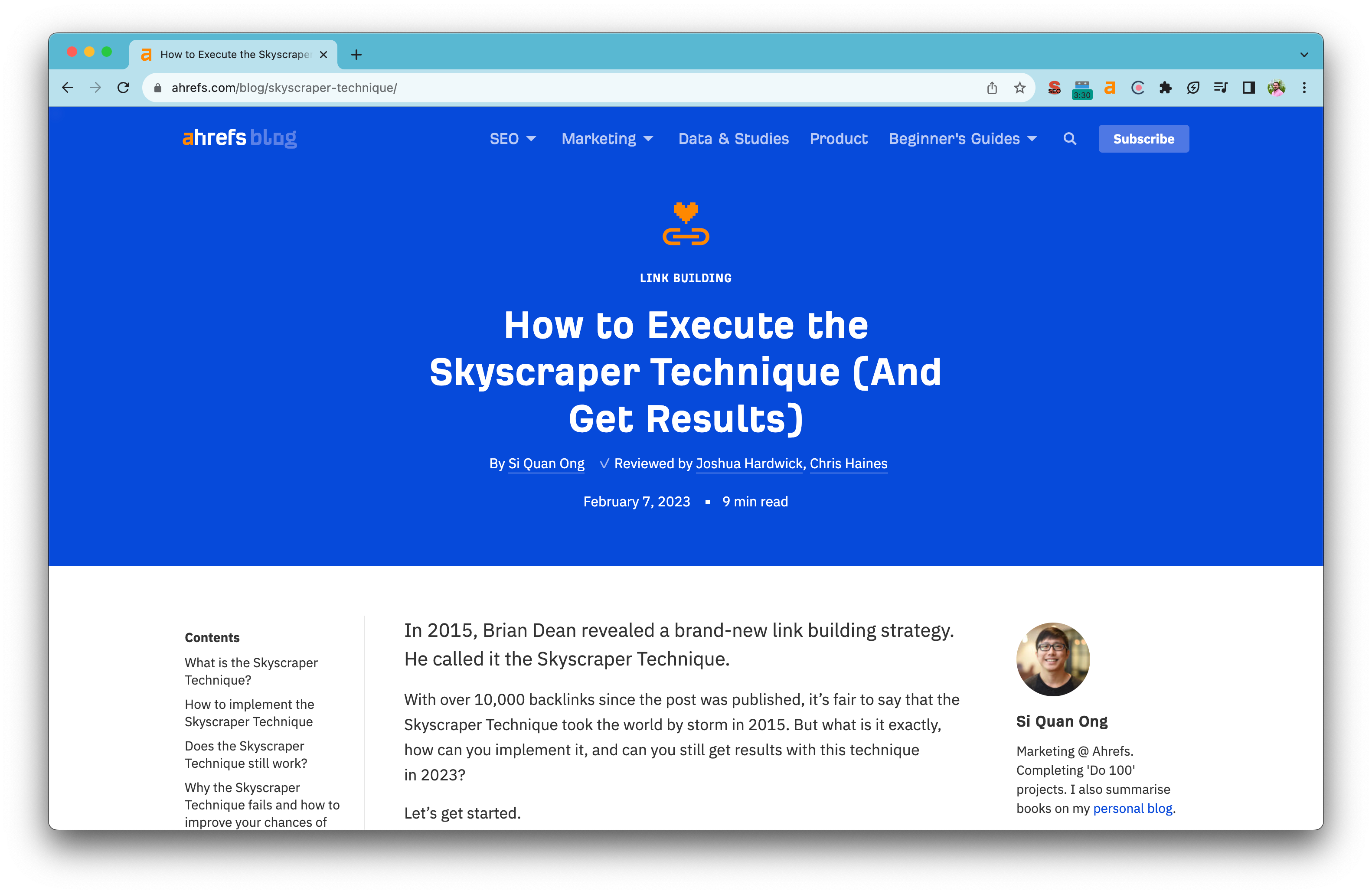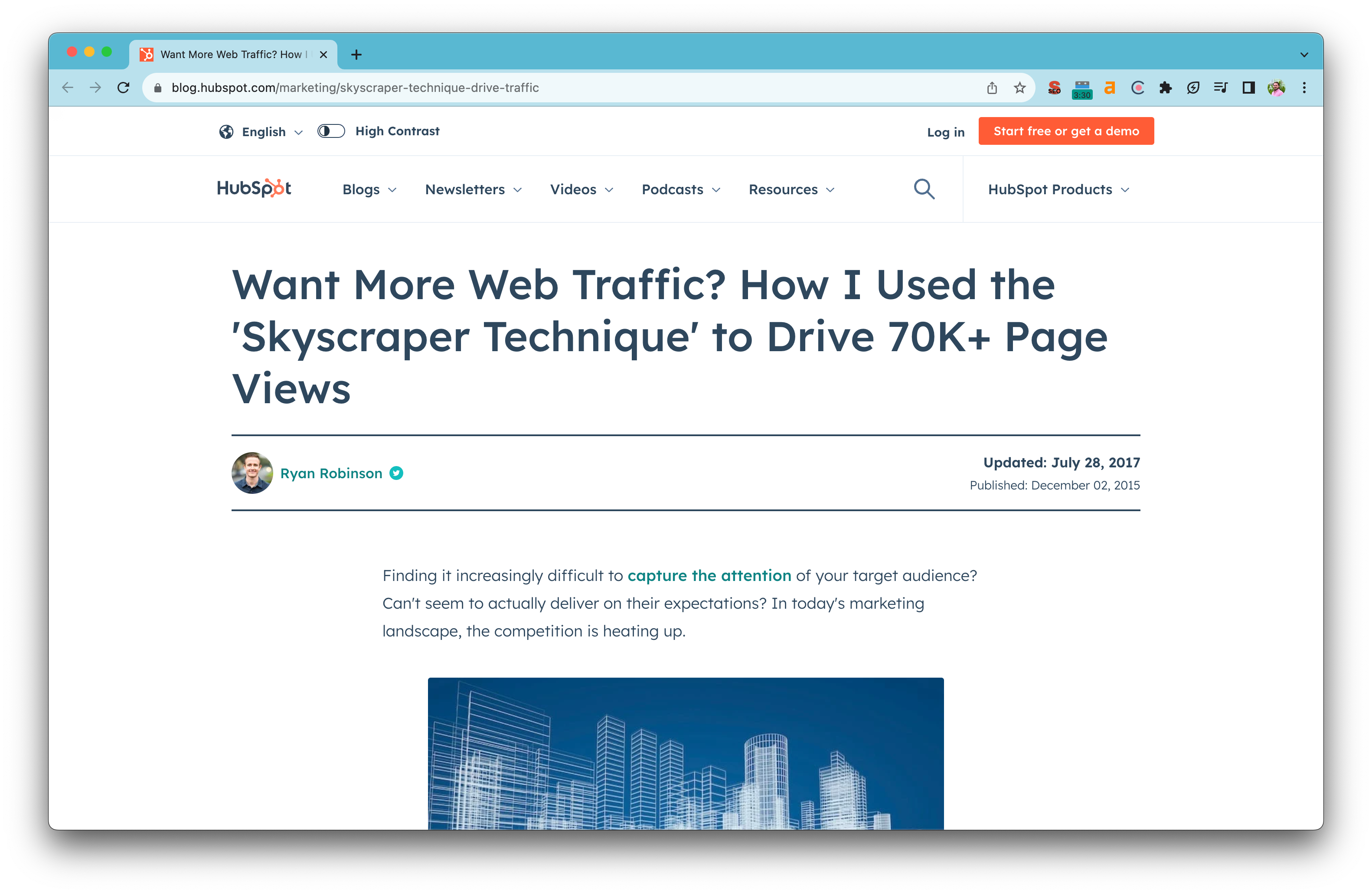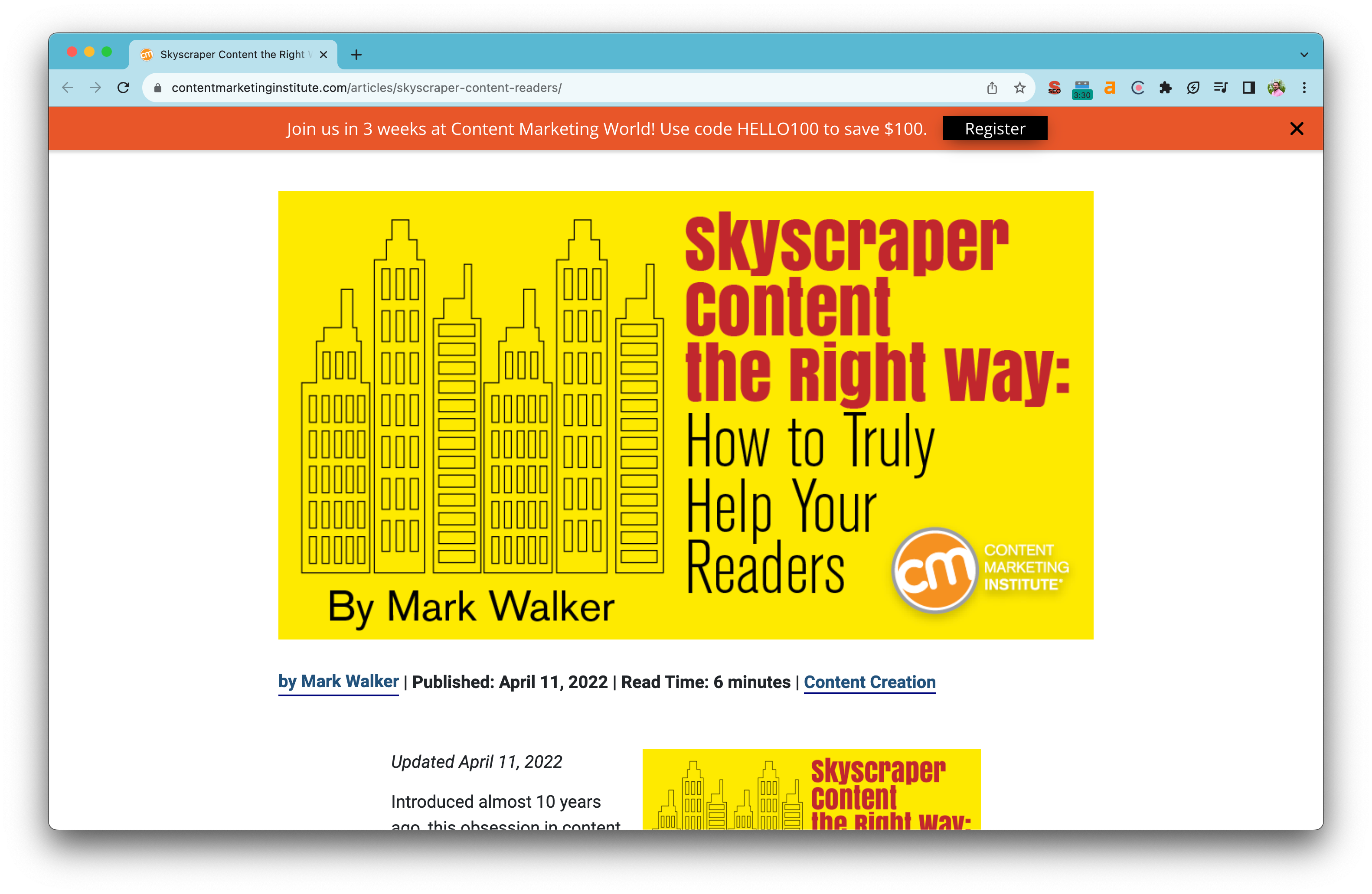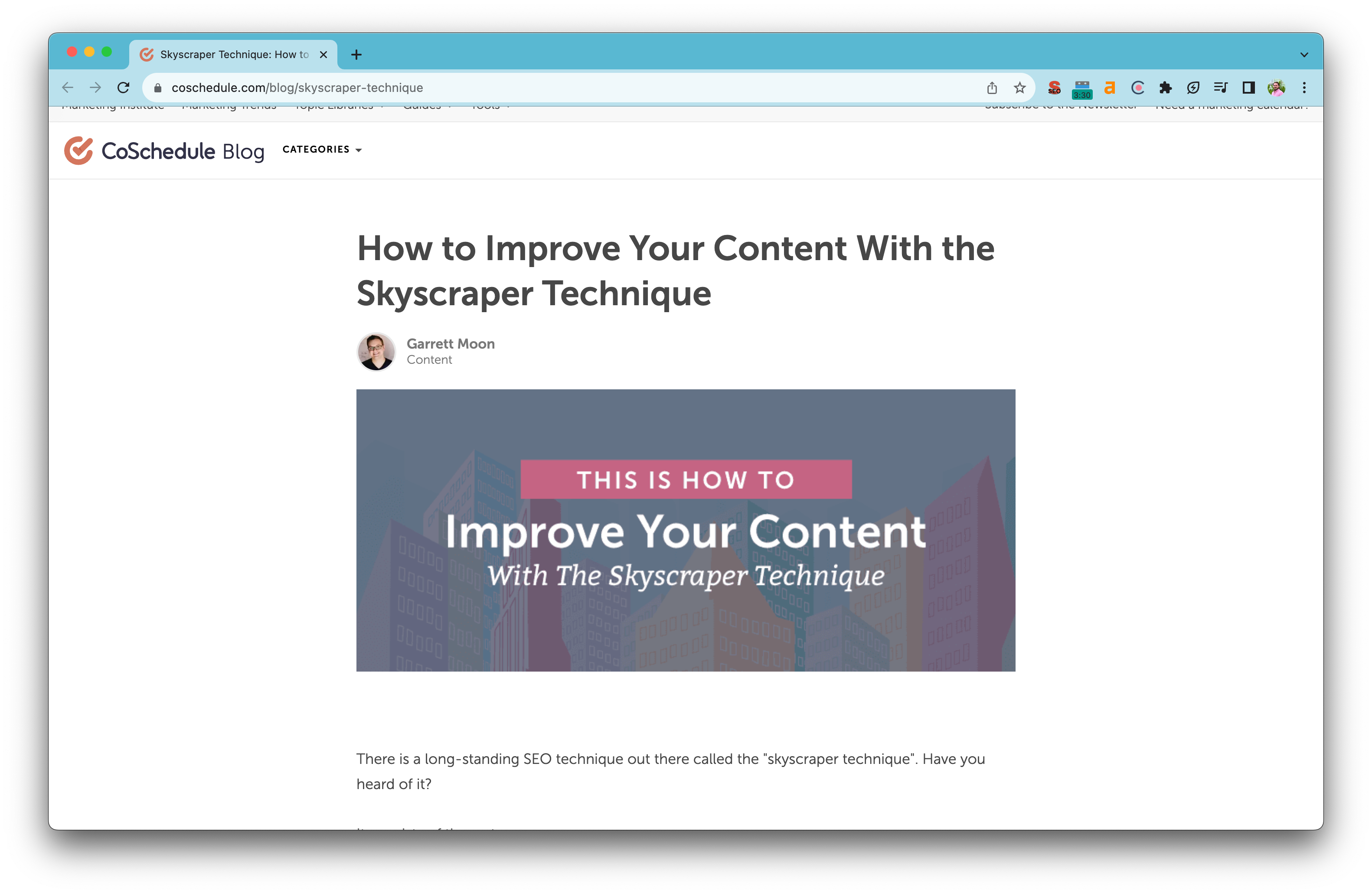SEO Skyscraper Method + ChatGPT Data Mining = Winning the SERP
September 18th, 2023 by
I can’t believe I’m sharing this, but after doing it a few times, I realized that the Skyscraper Technique, when paired with ChatGPT data mining, is too good to keep to myself.
But look, don’t tell anyone else, alright?
Everybody’s afraid of the impact of derivative content. I say, if you can’t beat ’em, join ’em.
Everybody's afraid of derivative content. I say, if you can't beat 'em, join 'em. Click To TweetLean into the power of derivative content and take a lesson from Brian Dean in the Backlinko heyday.
A Little Background
In March 2023, I wrote “ChatGPT: Data Mining and SEO With OpenAI and Bing.” Since then, a lot has changed with machine learning, AI, OpenAI, ChatGPT, and content.
At the time, I was getting back from Pubcon, having presented on AI content (as much as we understood at the time), and was super pumped about the opportunity.
I started experimenting with sampling existing content to build personas for voice and tone, but it was nothing like we’re able to do now. With updates to the core OpenAI GPT, both in the underlying technology and in the size and scope of content one can process, we can go both deep and wide on topics.

The more recent ability to execute a web search with plugins and the expanded data exploration enable summarization and understanding of exceptionally long and complex topics.
The machine learning models and artificial intelligence technology are amazing in and of themselves. The killer app, in my experience, is the ability to analyze the aggregated content of those articles you’re summarizing and glean really useful information.
ChatGPT As a Data Analysis Engine
In a recent experiment, I had ChatGPT summarize the top ten articles on a topic, including highlighting unique positions. This use of natural language processing makes ChatGPT a much more valuable tool to perform tasks where the data collection and correlation analysis are themselves a competitive edge.
It’s simple to get started — search Google for your target keyword. The answer will give you a ton of new ideas and more links than you know what to do with.
Then, use ChatGPT data mining to extract common elements. In this case, we’re talking about the most commonly cited higher education marketing strategies.
Search Google for your target keyword. You will get a ton of ideas and more links than you know what to do with. Then, use ChatGPT data mining to extract common elements. Click To Tweet
It’s these kinds of classification tasks where I think ChatGPT really shines.
I’m looking forward to the very near future, where AI image tools like Midjourney and Dall-E can take the language model output and turn it into data visualization. Obviously, getting accurate responses from the code can lead to a better piece of content.
This is just one of many factors that must be addressed before data scientists can rely on this powerful tool.
Will this work for every subject? Maybe not, but for any topic with abundant informational content available, it should be effective.
What Is the SEO Skyscraper Technique?
The Skyscraper Technique was popularized by Brian Dean at Backlinko. As you would imagine, it’s been imitated, misquoted, and SEO’d beyond belief.
- Step 1: Find link-worthy content.
- Step 2: Make something even better.
- Step 3: Reach out to the right people.
Note that the first filter is about links. Links are great and a strong signal of authority, but since Dean’s original article, Google has moved much further down the road toward a semantic, entity-based web.
Links are still critical to ranking, but it’s widely acknowledged they are also very manipulable.
This means that the page’s content and its relationship to already recognized entities can be as important as the links pointing to it.
In fact, if you believe Kyle Roof or Koray Tuğberk Gübür, you might think you can own the SERP without links at all.
So, the difference in this approach is that, instead of looking at a single piece or a small set of content, we look at all the content to which Google is giving the love.
Instead of looking at a single piece or a small set of content, we look at all the content to which Google is giving the love. Click To TweetAnother difference is the respect we show the other ranked articles we’re referencing. We’re not just trying to one-up them — we’re giving them their dues with a summary and a link.
And yes, by including the summary, we’re assuring we include all those juicy semantic entities and keywords in our article, too. We’re, therefore, also relieved of the challenge of keyword research because we know these articles rank. Look at a great number of sources and build the tallest skyscraper, and you win.

And finally, by syndicating the content we’ve created, with derivative content enabled by AI, we’re presenting a 360-degree view of both the content and the link universe.
And we’re setting ourselves up so that the first links pointing back are both super authoritative and, potentially, linkable assets in their own right.
How Do You Use ChatGPT for Data Mining?
In the last six months, ChatGPT has become a fantastic tool for data mining. With the addition of web crawling and integrations to third-party data sources like Google Sheets, what was previously just a content regurgitator is now a proper data analysis tool.
In my original article on ChatGPT data mining, ChatGPT didn’t have live web crawling ability and was still giving out a lot of information it shouldn’t have been. In fact, it was giving me email addresses — accurate or not — for Pubcon speakers, past and present.
But, as that article showed, you can’t trust ChatGPT to tell the truth, and there’s a fair likelihood that some of those addresses are made up.
You can’t trust ChatGPT to tell the truth, and there’s a fair likelihood that some of the information is made up. Click To TweetAnd just like that, it went away.
From the earliest days of ChatGPT, you could ask it to identify frequency, relationships, and even format information in tabular form. But you still couldn’t trust it.
In an example I’ve shared in the past, I asked ChatGPT for neighborhoods arranged by city within the greater New Orleans area. And it gave me a well-organized response. It looked accurate to me, but I’m sure it wasn’t entirely comprehensive.
Now, with ChatGPT ingesting data from web crawling and Google Sheets, for instance, it’s the content that gets ingested one has to worry about, not ChatGPT’s famous hallucinations.
I even made ChatGPT use the “F” word once 😀
I'm human, I'm helpful, some of this is AI, and that's OK. Click To Tweet
The Prompt I Used to Summarize the Articles
As anyone familiar with the ChatGPT language patterns knows, you must ask follow-up questions to produce great content:
Please write a synopsis for each of the articles at the following URLs.
Please use the article’s HTML title as the heading and include enough detail that I don’t need to actually read the article.
If an article references multiple strategies, please list them.
Please identify any unique or noteworthy positions taken by the author.
Please include the URL immediately below the HTML title.
I used the Access Link plugin and pasted the URLs of Google’s top 10 ranking entries.
In prior iterations of this idea, pre-ChatGPT plugins, I have copied and pasted the whole article or used BingGPT — pour one out for BingGPT, y’all.
Now, I know some of you prompt engineering pros will find ways to improve this. If so, please share.
Keep in mind that I wasn’t trying to have ChatGPT write my whole article. I needed it to extract and present information from other articles that I could review and comment on.
The Prompt I Used to Extract the Top 10 List
As often happens with prompt engineering, I had to iterate my way to the final, golden output.
I started with:
Please identify the most common strategies cited in the articles synopsized below - and then copy in the text of all the synopses Click To TweetPlease identify the most common strategies cited in the articles synopsized below:
[Text of ALL of the synopses from the prior exercise]
This gave me a long list that didn’t seem to have any prioritization, so I asked for the top three, then the top five, and finally:
Top 10 in order of frequency?
And that was the money. From that, I got a great list with brief descriptions of the top 10 higher education marketing strategies. Given the iteration and the clarification in the prompt, I was also more inclined to believe the output.
If you are going to use this technique for something more serious than SEO, please be sure to fact-check both the source articles and ChatGPT’s interpretation of them.
Some Examples of ChatGPT Data Analysis for the SEO Skyscraper Technique
For this exercise, I used the following prompt:
Please write a synopsis for each of the articles at the following URLs.
Please use the article’s HTML title as the heading.
Please include enough detail that I don’t need to actually read the article.
Please include any background resources cited in the article, the actual strategies used, and the steps in order.
Please also identify ways in which they may disagree with the original article: https://backlinko.com/skyscraper-technique.
Please identify any unique or noteworthy positions taken by the author.
Please include the URL immediately below the HTML title.
Articles:
[List of articles to analyze]
Once all the articles were summarized, I asked ChatGPT to help identify some recurring themes.
Most Cited Methods for Keyword Research in an SEO Skyscraper Link Building Strategy
Most Cited Methods for Keyword Research in an SEO Skyscraper Link Building Strategy Click To TweetBased on the articles reviewed, the most frequently cited methods for keyword research, in order of frequency, are:
- Use SEO Tools: Most articles emphasized the importance of using specialized SEO tools to identify high-performing content and relevant keywords. The most frequently mentioned tools were:
- Ahrefs: Especially its “Content Explorer” and “Keywords Explorer” features.
- Semrush: Known for its keyword research and domain overview capabilities.
- Analyze Competitor Content: Many articles recommend examining content from competitors or top-performing content in the niche. This method helps identify what topics or keywords are already successful and where there might be gaps or areas for improvement.
- High vs. Low Competition Keywords: There was a notable emphasis on the strategy of choosing between high and low-competition keywords. While traditional approaches often focus on low-competition keywords, some methods, like the Shotgun Skyscraper, suggest targeting high-competition keywords due to their potential for more backlinks.
- Google’s “Searches Related to” Section: A significant number of articles pointed to the utility of Google’s own search results. The “Searches Related to” section at the bottom of search results can provide insights into related keywords and topics that users search for.
- Long-Tail Keywords: Several articles highlighted the importance of targeting long-tail keywords. These are longer, more specific keyword phrases that might have lower search volumes but can be easier to rank for and attract a more targeted audience.
While these methods were the most frequently cited, it’s worth noting that the effectiveness of each method can vary based on the specific goals of the content and the niche in which one is operating.
Most Cited Methods of Outreach for SEO Skyscraper Link Building
Most Cited Methods of Outreach for SEO Skyscraper Link Building Click To TweetBased on the articles reviewed, the most frequently cited methods for link outreach, in order of frequency, are:
- Personalized Email Outreach: Almost all articles emphasized the importance of personalizing outreach emails. This involves:
- Addressing the recipient by name.
- Mentioning specific details about their content or website.
- Explaining why your content would be valuable to their audience.
- Use of Outreach Tools: Many articles mentioned the use of specialized outreach tools to streamline and automate the process. Some of the most frequently cited tools include:
- Hunter.io: For finding email addresses associated with a particular domain.
- Mailshake: For automating and tracking outreach campaigns.
- Respona: For acting as an all-in-one PR and link-building tool.
- Snov.io: For finding email addresses and conducting email outreach.
- Follow-Up Emails: Several articles highlighted the importance of sending follow-up emails if there’s no response to the initial outreach. This can increase the chances of getting a reply, but it’s crucial to strike a balance to avoid being too pushy.
- Offering Value: Many articles emphasized the need to offer value in the outreach email. This could be in the form of:
- Sharing your superior content as a resource.
- Suggesting specific improvements or updates to their existing content.
- Offering to share their content on your platforms in return.
- Segmentation and Targeting: It’s essential to segment your list of prospects and tailor your outreach accordingly. This involves:
- Identifying websites or blogs that are relevant to your niche.
- Targeting sites that have linked to similar content in the past.
- Avoiding sites that are unlikely to link back due to competitive reasons or misalignment in content themes.
In addition to these methods, building genuine relationships and networking in your industry was a recurring theme. Gaining trust and rapport can significantly increase the chances of securing backlinks.
So, You Want to See the Synopses?
Since this is more of an explanatory article, I’m only going to include a handful, rather than the full top 10.
Ahrefs: The Skyscraper Technique: How to Build High-Quality Backlinks to Your Content
Synopsis: Ahrefs: The Skyscraper Technique: How to Build High-Quality Backlinks to Your Content Click To Tweet
https://ahrefs.com/blog/skyscraper-technique/
Synopsis: The article begins by referencing Brian Dean’s introduction of the Skyscraper Technique in 2015, which quickly gained popularity. The technique works by improving upon existing popular content and replicating its backlinks.
Steps to Implement the Skyscraper Technique:
- Find Relevant Content With Lots of Backlinks:
- Use Ahrefs’ Site Explorer to identify pages with a high number of referring domains.
- Use Ahrefs’ Content Explorer to search for content on a broad topic related to your niche.
- Use Ahrefs’ Keywords Explorer to identify high KD score keywords and the top-ranking pages for them.
- Make it Better:
- Improve the content’s length, freshness, design, and depth.
- Reach Out to the Right People:
- Use email outreach to contact those who have linked to the original content you’ve improved upon. Find these people using Ahrefs’ Site Explorer.
Does the Skyscraper Technique Still Work? While the technique has been oversaturated over the years, many SEOs and marketers still believe in its effectiveness. However, only 18% of SEOs still use it, as per Aira’s Annual State of Link Building report.
Reasons the Skyscraper Technique Might Fail & How to Improve:
- Sending Only Brian’s Email Template: Many SEOs used Brian’s original email template verbatim, leading to its overuse and decreased effectiveness.
- Not Segmenting Your Prospects: Tailor outreach emails based on the context in which prospects linked to the original content.
- Not Reaching Out to Enough People: A link building strategy is a numbers game. Expand the list of link prospects by also considering backlinks from other top-ranking pages on the same topic.
- Thinking Bigger Equals Better: Simply increasing the length or number of items in content doesn’t necessarily add value. Curation and quality are key.
- Not Considering Brand: Content quality isn’t the only factor; the reputation of the content creator or brand also plays a role.
Final Thoughts: The Skyscraper Technique can be effective if executed correctly. It’s essential to focus on quality, value, and consistent content creation.
Comparison With the Original Article by Backlinko:
- Both articles emphasize the importance of improving existing content and reaching out for backlinks.
- Ahrefs provides specific tools and methods to find and analyze potential content for the Skyscraper Technique.
- Ahrefs highlights the potential pitfalls and oversaturation of the technique, suggesting that its effectiveness might be limited in the current landscape.
- The Ahrefs article emphasizes the importance of brand reputation in the success of the Skyscraper Technique, which is not heavily discussed in the original Backlinko article.
Unique or Noteworthy Positions:
- The article suggests that the Skyscraper Technique’s popularity might have decreased because SEOs are now focusing more on content than links.
- The emphasis on the importance of brand reputation and the potential pitfalls of the Skyscraper Technique provides a more nuanced perspective on its effectiveness.
HubSpot: How to Use the Skyscraper Technique to Drive Traffic
Synopsis: HubSpot: How to Use the Skyscraper Technique to Drive Traffic Click To Tweet
https://blog.hubspot.com/marketing/skyscraper-technique-drive-traffic
Synopsis: The article discusses the increasing difficulty of capturing audience attention in the current marketing landscape. It introduces the Skyscraper Technique as a solution, detailing its creation by Brian Dean of Backlinko. The technique involves improving existing popular content and then reaching out for backlinks.
What’s the Skyscraper Technique?
- It’s a method for turning content into high-quality backlinks.
- The process involves researching popular content, creating a better version, and then reaching out to those who linked to the original content.
- Reasons for its effectiveness include:
- Proven demand for the content topic.
- Engaging an already primed audience.
- Potential for high search rankings.
How HubSpot Used the Skyscraper Technique:
- The author shares a personal experience where they saw a similar article from Fast Company about a freelance hourly rate calculator.
- They created a visually appealing infographic on the same topic and promoted it.
- The result was over 8,200 shares, 72,000+ page views, and 3,648 new email subscribers.
6-Step Checklist for Using the Skyscraper Technique:
- Research and Uncover Opportunities: Use tools like Google Alerts, BuzzSumo, HubSpot’s Keyword App, and Google’s Keyword Planner.
- Build a List of Potential Distribution Partners: Start with known contacts and expand using BuzzSumo.
- Create Better Content: Consider different content mediums and focus on delivering more value.
- Promote to Your Audience: Share on social channels, email lists, and internally.
- Reach Out to the Right People: Contact influencers, brands, and bloggers who share related content.
- Stay Current: Update content to ensure it remains relevant over time.
Comparison With the Original Article by Backlinko:
- Both articles emphasize the importance of improving upon existing content and reaching out for backlinks.
- HubSpot provides a personal case study to showcase the effectiveness of the technique.
- HubSpot offers a step-by-step checklist, making the process more actionable for readers.
Unique or Noteworthy Positions:
- The article emphasizes the importance of staying current and updating content over time.
- HubSpot’s personal case study provides a tangible example of the Skyscraper Technique’s success, highlighting the potential benefits when executed correctly.
Content Marketing Institute: Skyscraper Content the Right Way: How to Truly Help Your Readers
Synopsis: Content Marketing Institute: Skyscraper Content the Right Way: How to Truly Help Your Readers Click To Tweet
https://contentmarketinginstitute.com/articles/skyscraper-content-readers/
Synopsis: The article critiques the overuse and misuse of the Skyscraper Technique in content marketing. While acknowledging the original brilliance of the concept, the author argues that many content creators equate the technique with producing longer content, rather than more valuable content.
What Is Skyscraper Content?
- It involves finding successful content, reverse-engineering its success, creating a better version, and replicating its distribution strategy.
- The author encourages readers to refer to Brian Dean’s post on Backlinko for a good example of the methodology.
What’s Wrong With Skyscraper Content?
- Many content creators mistakenly believe that longer content equates to more value.
- The focus on length can lead to padding posts with unnecessary information, making it difficult for readers to find valuable insights.
- Skyscraper content can become inaccessible if it’s always lengthy and doesn’t consider the reader’s experience.
- Google’s algorithm prioritizes content that meets readers’ needs, so skyscraper content that doesn’t prioritize readers may not rank well.
Unoriginal Content:
- Skyscraper content can lead to unoriginality, as creators model their content after existing successful pieces.
- The challenge is to find a unique angle and add value to the original topic.
- Merely adding more words without offering a fresh perspective can make the content redundant.
How to Make Skyscraper Content Work:
- Genuine Need: Update content that’s outdated or full of broken links.
- Unique Angle: Offer a new perspective or personal account on a familiar topic.
- Focus on Value, Not Text: The goal is to create content that’s more valuable, not necessarily longer. For instance, transform a long article into a video or an interactive tool.
Conclusion: While the Skyscraper Technique can be powerful, it’s essential to use it correctly. Content creators should prioritize value over length and ensure they’re genuinely helping their readers. If the content doesn’t add value, it’s better to create something original that delights the audience.
Comparison With the Original Article by Backlinko:
- Both articles discuss the Skyscraper Technique’s methodology.
- The Content Marketing Institute article critiques the overuse and misuse of the technique, emphasizing the importance of value over length.
- The article suggests that many content creators misunderstand the Skyscraper Technique, leading to redundant and unoriginal content.
Unique or Noteworthy Positions:
- The article offers a critical perspective on the Skyscraper Technique, highlighting its potential pitfalls.
- It emphasizes the importance of originality and value in content creation, rather than merely replicating successful content.
CoSchedule: The Skyscraper Technique: Why You Should Use It
Synopsis: CoSchedule: The Skyscraper Technique: Why You Should Use It Click To Tweet
https://coschedule.com/blog/skyscraper-technique
Synopsis: The article introduces the Skyscraper Technique, a three-step SEO method that involves finding top-performing content, creating better content, and then promoting it to gain backlinks. The author emphasizes that while the technique is rooted in SEO, it’s beneficial for all content marketers, not just SEO experts.
Understanding the Skyscraper Technique:
- It’s not exclusively an SEO strategy.
- It’s not a license to steal or replicate someone else’s content without adding value.
How to Use the Skyscraper Technique:
- Find Top-Performing Content:
- Use tools like BuzzSumo to identify popular content based on keywords.
- Analyze the top content to understand its themes, content length, number of images, and overall quality.
- Use tools like the Moz Toolbar to gather backlink information and understand the authority of the content.
- Create Better Content Than Current Top Performers:
- Make content longer and more in-depth.
- Incorporate rich content like images, videos, and infographics.
- Delve deeper into the topic to provide more value.
- Think strategically about SEO and keyword usage.
- Get People to Link to Your Content:
- While promoting with social media marketing is a start, the key is to earn backlinks by producing superior content.
- The focus should be on generating better content ideas and improving content quality.
Conclusion: The Skyscraper Technique provides insights into what content is performing well and what’s being shared the most. It’s a valuable method for generating new content ideas and improving content marketing strategies. The ultimate goal isn’t to replicate but to innovate and produce better content.
Comparison With the Original Article by Backlinko:
- Both articles describe the Skyscraper Technique’s methodology.
- CoSchedule emphasizes the technique’s applicability beyond just SEO experts and highlights its broader benefits for content marketing.
- The article provides specific tools and methods to implement the technique effectively.
Unique or Noteworthy Positions:
- The article stresses that the Skyscraper Technique is not just for SEO experts but is a valuable strategy for all content marketers.
- It underscores the importance of adding value and not merely replicating existing content.
Semrush: What Is the Skyscraper Technique?
Synopsis: Semrush: What Is the Skyscraper Technique? Click To Tweet
https://www.semrush.com/blog/skyscraper-technique/
Synopsis: Semrush provides a comprehensive guide on the Skyscraper Technique, emphasizing its role in SEO link building. The article breaks down the technique’s definition, its benefits for SEO, and a step-by-step guide on its execution. It also discusses the importance of skyscraper content and the factors that make it stand out.
Key Points:
- Definition of the Skyscraper Technique: A method that involves identifying competitive content with many backlinks, improving it, and then encouraging sites to link to the superior content.
- Skyscraper Content: Content crafted as part of the Skyscraper Technique, designed to be a superior version of a widely linked resource. It should be more comprehensive, up-to-date, credible, and presented effectively.
- Benefits of the Skyscraper Technique for SEO:
- Inheriting links that previously pointed to competitors.
- Earning backlinks on pages with established traffic and authority.
- Encouraging the creation of quality content.
- Scalability.
- Implementation Steps:
- Find Competitive Content: Identify content types suitable for the Skyscraper Technique, such as how-to guides, comparison guides, listicles, and more.
- Analyze Competitors’ Content: Use tools like Semrush’s Backlink Analytics to find competitors’ most linked pages.
- Review Backlink Opportunities: Determine the potential and value of inheriting specific backlinks.
- Create Skyscraper Content: Outdo the competition by being more comprehensive, adding unique insights, improving user experience, establishing credibility, and incorporating images and videos.
- Optimize Content for Search: Ensure the content is optimized for relevant keywords and follows on-page SEO techniques.
- Conduct Email Outreach: Identify link building prospects and send personalized pitches to encourage them to link to your content.
Conclusion: The Skyscraper Technique is a targeted approach to link building that can yield significant SEO benefits when executed correctly.
Unique or Noteworthy Positions:
- Semrush provides a detailed breakdown of the types of content suitable for the Skyscraper Technique, offering clarity on content selection.
- The article introduces tools and resources available within the Semrush platform, guiding readers on how to optimize their skyscraper content and conduct effective outreach.
- It emphasizes the importance of personalizing email outreach and provides a sample skyscraper email pitch to inspire readers.
Brian Dean Didn’t Have Today’s Software
Yes, machine learning and natural language processing are making the collection and production of website content more approachable. Data analysis is also helping with optimization. With tools like SurferSEO, Frase, and others, you can ensure your content isn’t just longer and more comprehensive, but also better optimized.
Link builders know that one of the best ways to get new links is for your site to be the answer to what people are searching for.
There is an explosion in data exploration products for on-site optimization. The challenge isn’t finding one — it’s limiting yourself to just one.
There is an explosion in data exploration products for on-site optimization. The challenge isn't finding one — it's limiting yourself to just one. Click To TweetNo lie, I currently actively use at least five machine learning-enabled SaaS products.
Concluding Thoughts: No, It’s Not Data Science
Hopefully, you see how incredibly powerful this technique can be.
Like many users of AI content — consistent with human nature, you may be tempted to take shortcuts.
SEO tactics, when abused, lose effectiveness. So, please don’t abuse this.
The SEO Skyscraper Technique with ChatGPT Data Mining will be most useful when a human, knowledgeable in the topic, is making a good AI Sandwich. If you copy and paste and perfunctorily add the non-AI bits, you won’t be adding value to the internet and will eventually see any rankings you did gain disappear.

Something noteworthy in this example is that I’m seeing more sites that aren’t accessible to ChatGPT. I wonder if this is due to those webmasters blocking the OpenAI crawler.
I’m seeing more sites that aren’t accessible to ChatGPT. I wonder if this is due to those webmasters blocking the OpenAI crawler. Click To TweetAlso, ChatGPT has some words that show up again and again. You should be on the lookout for these so you can edit them where appropriate. “Delve” and “boost,” particularly in the context of SEO, come up again and again.
You’ll notice I tend to be polite when I’m making requests of ChatGPT. This is for two reasons. First, I’m generally a polite person. Politeness counts. Second, when the robots take over, I want every advantage I can get. I would rather they see me as a collaborator 🙂
Finally, as the list of articles to analyze gets longer, you may need to prompt ChatGPT to “continue.”
If you’ve already been using this technique, please hit me up on Twitter and show me some examples, @w2scott.
If you’re just getting started, I hope you find it as useful as I have.
SEO Skyscraper Method + ChatGPT Data Mining = Winning the SERP Click To TweetSources:
https://ahrefs.com/blog/skyscraper-technique/
https://backlinko.com/skyscraper-technique
https://blog.hubspot.com/marketing/skyscraper-technique-drive-traffic
https://contentmarketinginstitute.com/articles/skyscraper-content-readers/
https://coschedule.com/blog/skyscraper-technique
https://learn.g2.com/skyscraper-technique
https://leavingworkbehind.com/skyscraper-writing-method/
https://marketingartfully.com/how-to-write-long-skyscraper-blog-posts/
https://marketinginsidergroup.com/content-marketing/does-the-skyscraper-technique-work-anymore/
https://respona.com/blog/skyscraper-technique/
https://snov.io/blog/skyscraper-technique/
https://wpmudev.com/blog/skyscraper-seo-link-building-technique/
https://www.authorityhacker.com/link-building-techniques/
https://www.clearvoice.com/resources/how-to-build-backlinks-with-the-skyscraper-content-technique/
https://www.elegantthemes.com/blog/wordpress/how-to-use-the-skyscraper-technique-to-boost-seo
https://www.lean-labs.com/blog/how-to-write-a-skyscraper-post-blog-post-template
https://www.livingthedreamrtw.com/skyscraper-posts-in-travel-writing
https://www.redefineyourmarketing.com/blog/the-skyscraper-link-building-technique

